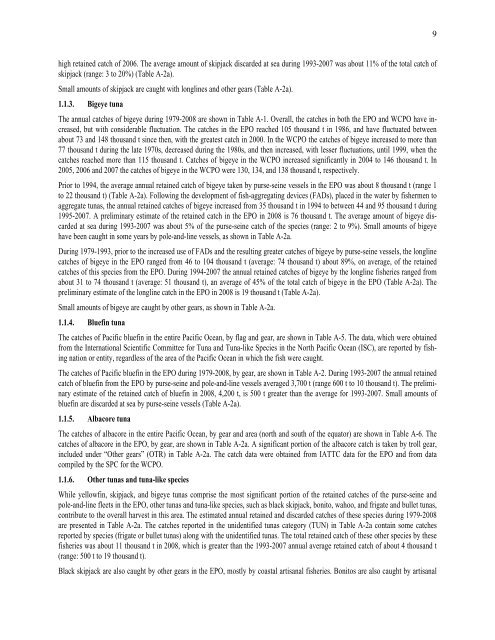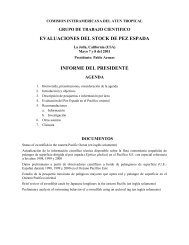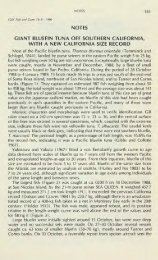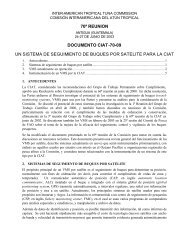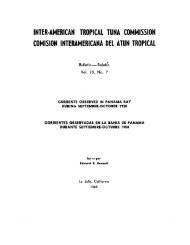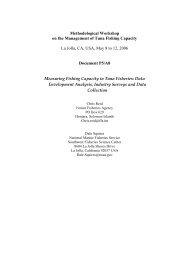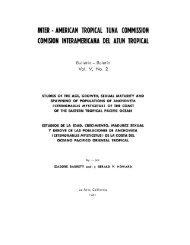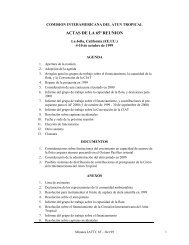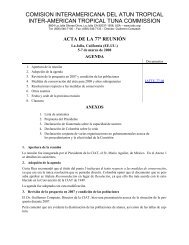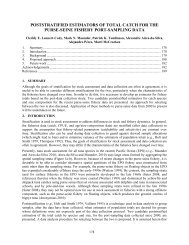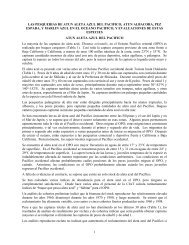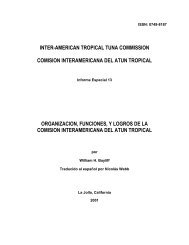INTER-AMERICAN TROPICAL TUNA COMMISSION - Comisión ...
INTER-AMERICAN TROPICAL TUNA COMMISSION - Comisión ...
INTER-AMERICAN TROPICAL TUNA COMMISSION - Comisión ...
- No tags were found...
You also want an ePaper? Increase the reach of your titles
YUMPU automatically turns print PDFs into web optimized ePapers that Google loves.
9high retained catch of 2006. The average amount of skipjack discarded at sea during 1993-2007 was about 11% of the total catch ofskipjack (range: 3 to 20%) (Table A-2a).Small amounts of skipjack are caught with longlines and other gears (Table A-2a).1.1.3. Bigeye tunaThe annual catches of bigeye during 1979-2008 are shown in Table A-1. Overall, the catches in both the EPO and WCPO have increased,but with considerable fluctuation. The catches in the EPO reached 105 thousand t in 1986, and have fluctuated betweenabout 73 and 148 thousand t since then, with the greatest catch in 2000. In the WCPO the catches of bigeye increased to more than77 thousand t during the late 1970s, decreased during the 1980s, and then increased, with lesser fluctuations, until 1999, when thecatches reached more than 115 thousand t. Catches of bigeye in the WCPO increased significantly in 2004 to 146 thousand t. In2005, 2006 and 2007 the catches of bigeye in the WCPO were 130, 134, and 138 thousand t, respectively.Prior to 1994, the average annual retained catch of bigeye taken by purse-seine vessels in the EPO was about 8 thousand t (range 1to 22 thousand t) (Table A-2a). Following the development of fish-aggregating devices (FADs), placed in the water by fishermen toaggregate tunas, the annual retained catches of bigeye increased from 35 thousand t in 1994 to between 44 and 95 thousand t during1995-2007. A preliminary estimate of the retained catch in the EPO in 2008 is 76 thousand t. The average amount of bigeye discardedat sea during 1993-2007 was about 5% of the purse-seine catch of the species (range: 2 to 9%). Small amounts of bigeyehave been caught in some years by pole-and-line vessels, as shown in Table A-2a.During 1979-1993, prior to the increased use of FADs and the resulting greater catches of bigeye by purse-seine vessels, the longlinecatches of bigeye in the EPO ranged from 46 to 104 thousand t (average: 74 thousand t) about 89%, on average, of the retainedcatches of this species from the EPO. During 1994-2007 the annual retained catches of bigeye by the longline fisheries ranged fromabout 31 to 74 thousand t (average: 51 thousand t), an average of 45% of the total catch of bigeye in the EPO (Table A-2a). Thepreliminary estimate of the longline catch in the EPO in 2008 is 19 thousand t (Table A-2a).Small amounts of bigeye are caught by other gears, as shown in Table A-2a.1.1.4. Bluefin tunaThe catches of Pacific bluefin in the entire Pacific Ocean, by flag and gear, are shown in Table A-5. The data, which were obtainedfrom the International Scientific Committee for Tuna and Tuna-like Species in the North Pacific Ocean (ISC), are reported by fishingnation or entity, regardless of the area of the Pacific Ocean in which the fish were caught.The catches of Pacific bluefin in the EPO during 1979-2008, by gear, are shown in Table A-2. During 1993-2007 the annual retainedcatch of bluefin from the EPO by purse-seine and pole-and-line vessels averaged 3,700 t (range 600 t to 10 thousand t). The preliminaryestimate of the retained catch of bluefin in 2008, 4,200 t, is 500 t greater than the average for 1993-2007. Small amounts ofbluefin are discarded at sea by purse-seine vessels (Table A-2a).1.1.5. Albacore tunaThe catches of albacore in the entire Pacific Ocean, by gear and area (north and south of the equator) are shown in Table A-6. Thecatches of albacore in the EPO, by gear, are shown in Table A-2a. A significant portion of the albacore catch is taken by troll gear,included under “Other gears” (OTR) in Table A-2a. The catch data were obtained from IATTC data for the EPO and from datacompiled by the SPC for the WCPO.1.1.6. Other tunas and tuna-like speciesWhile yellowfin, skipjack, and bigeye tunas comprise the most significant portion of the retained catches of the purse-seine andpole-and-line fleets in the EPO, other tunas and tuna-like species, such as black skipjack, bonito, wahoo, and frigate and bullet tunas,contribute to the overall harvest in this area. The estimated annual retained and discarded catches of these species during 1979-2008are presented in Table A-2a. The catches reported in the unidentified tunas category (TUN) in Table A-2a contain some catchesreported by species (frigate or bullet tunas) along with the unidentified tunas. The total retained catch of these other species by thesefisheries was about 11 thousand t in 2008, which is greater than the 1993-2007 annual average retained catch of about 4 thousand t(range: 500 t to 19 thousand t).Black skipjack are also caught by other gears in the EPO, mostly by coastal artisanal fisheries. Bonitos are also caught by artisanal


